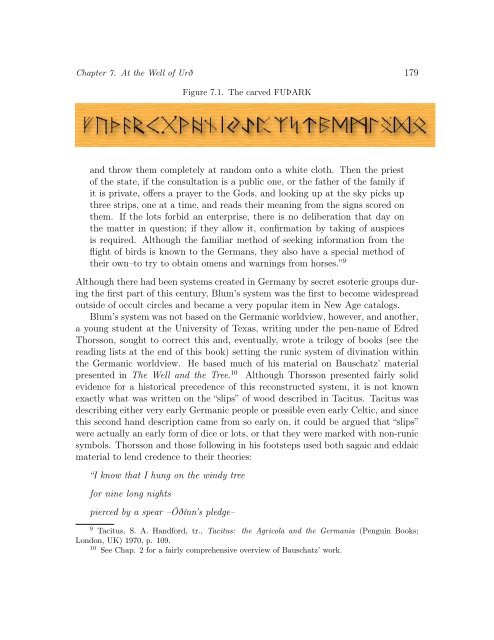Untitled - Awaken Video
Untitled - Awaken Video
Untitled - Awaken Video
You also want an ePaper? Increase the reach of your titles
YUMPU automatically turns print PDFs into web optimized ePapers that Google loves.
Chapter 7. At the Well of Urð 179<br />
Figure 7.1. The carved FUÞARK<br />
and throw them completely at random onto a white cloth. Then the priest<br />
of the state, if the consultation is a public one, or the father of the family if<br />
it is private, offers a prayer to the Gods, and looking up at the sky picks up<br />
three strips, one at a time, and reads their meaning from the signs scored on<br />
them. If the lots forbid an enterprise, there is no deliberation that day on<br />
the matter in question; if they allow it, confirmation by taking of auspices<br />
is required. Although the familiar method of seeking information from the<br />
flight of birds is known to the Germans, they also have a special method of<br />
their own–to try to obtain omens and warnings from horses.” 9<br />
Although there had been systems created in Germany by secret esoteric groups during<br />
the first part of this century, Blum’s system was the first to become widespread<br />
outside of occult circles and became a very popular item in New Age catalogs.<br />
Blum’s system was not based on the Germanic worldview, however, and another,<br />
a young student at the University of Texas, writing under the pen-name of Edred<br />
Thorsson, sought to correct this and, eventually, wrote a trilogy of books (see the<br />
reading lists at the end of this book) setting the runic system of divination within<br />
the Germanic worldview. He based much of his material on Bauschatz’ material<br />
presented in The Well and the Tree. 10 Although Thorsson presented fairly solid<br />
evidence for a historical precedence of this reconstructed system, it is not known<br />
exactly what was written on the “slips” of wood described in Tacitus. Tacitus was<br />
describing either very early Germanic people or possible even early Celtic, and since<br />
this second hand description came from so early on, it could be argued that “slips”<br />
were actually an early form of dice or lots, or that they were marked with non-runic<br />
symbols. Thorsson and those following in his footsteps used both sagaic and eddaic<br />
material to lend credence to their theories:<br />
“I know that I hung on the windy tree<br />
for nine long nights<br />
pierced by a spear –Óðínn’s pledge–<br />
9 Tacitus, S. A. Handford, tr., Tacitus: the Agricola and the Germania (Penguin Books;<br />
London, UK) 1970, p. 109.<br />
10 See Chap. 2 for a fairly comprehensive overview of Bauschatz’ work.
















